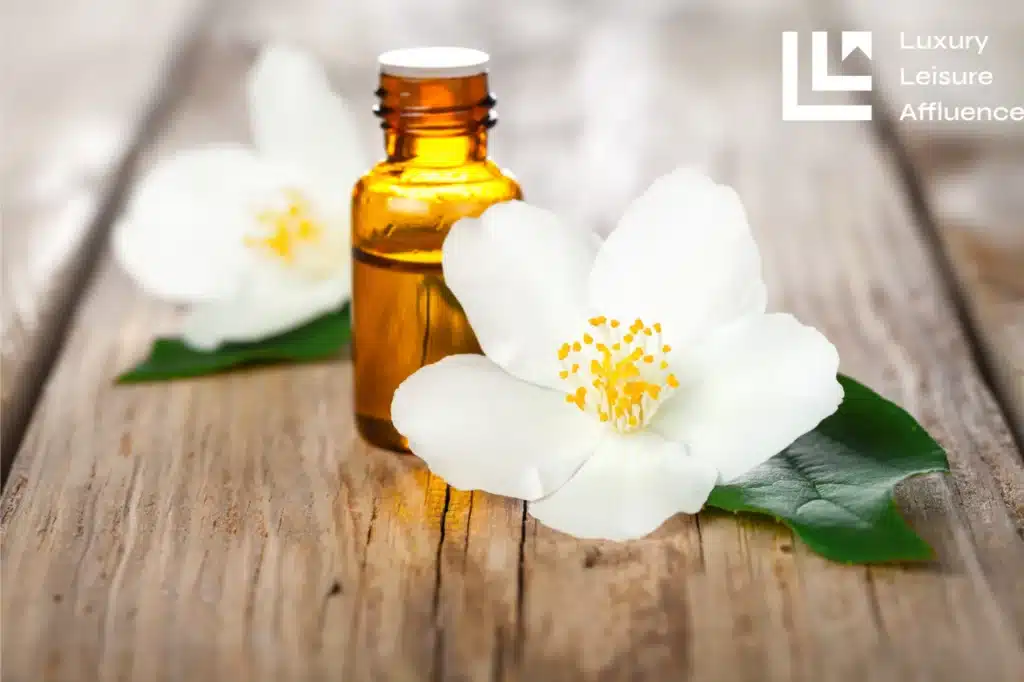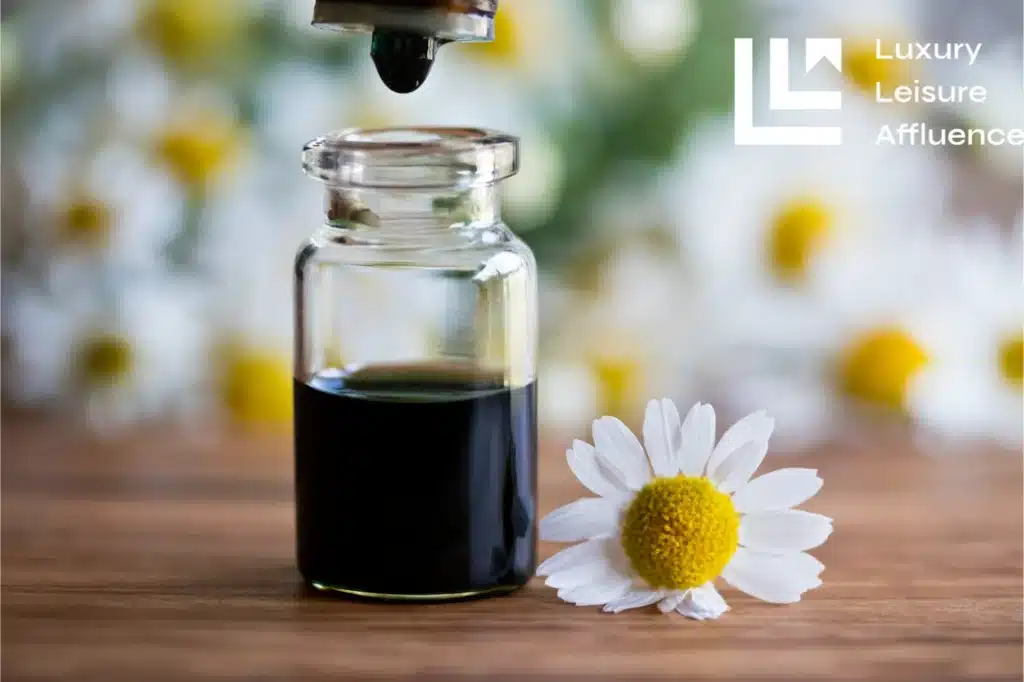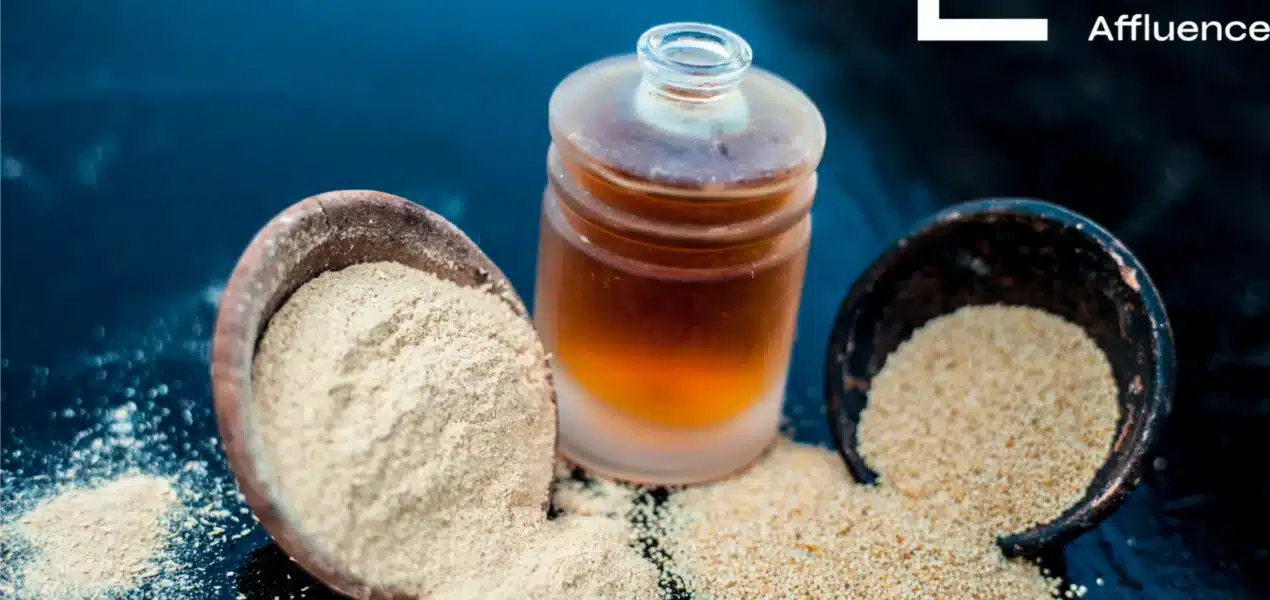Updated On: April 07, 2024 by Issraa Saeed
Luxury essential oils represent the pinnacle of quality, craftsmanship, and indulgence in aromatherapy. These exceptional oils are meticulously sourced, carefully extracted, and often derived from rare or exotic plant species. With a commitment to purity, sustainability, and unique aromatic profiles, luxury essential oil brands provide a sensory journey that captivates the senses and elevates the therapeutic experience. While they may come with a higher price tag, these oils offer a level of refinement and exclusivity that appeals to discerning individuals seeking the utmost quality and luxury. We will explain in this article the usage of essential oils, the most expensive ones and brands, and why they are expensive.
What Are Essential Oils?
Essential oils are plant extracts that capture various plants’ aromatic compounds and other beneficial properties. They are obtained through distillation or cold pressing processes, extracting the volatile compounds from flowers, leaves, bark, stems, and other plant parts.
These oils have been used for thousands of years in various cultures for their potential therapeutic and medicinal properties. Essential oils contain the natural essence, fragrance, and characteristics of the plant they are derived from. They are called “essential” because they represent the “essence” of the plant.
While essential oils can have potential benefits, they should be used cautiously. They are highly concentrated substances and can cause skin irritation or adverse effects if misused. So, it’s better to consult a qualified aromatherapist or healthcare professional before using essential oils for therapeutic purposes.
Are Essential Oils Useful and Therapeutic?
Yes, essential oils are widely recognised for their potential therapeutic benefits. However, depending on the individual and the specific oil used, essential oils’ effectiveness and therapeutic outcomes vary. Here are some of these common therapeutic effects:
- Relaxation and stress relief: Essential oils like lavender, chamomile, and bergamot are often used for their calming effects and can promote relaxation, reduce anxiety, and improve sleep quality.
- Mood enhancement: Citrus oils such as lemon, orange, and grapefruit are known for their uplifting and energising effects. They can help improve mood, boost mental clarity, and provide a sense of invigoration.
- Respiratory support: Eucalyptus, peppermint, and tea tree oil are frequently used for their potential benefits in supporting respiratory health. They can help relieve congestion, open airways, and ease breathing difficulties.
- Skincare: Many essential oils have effects that can benefit the skin; Tea tree oil is known for its antimicrobial and acne-fighting properties.
- Pain relief: Essential oils such as peppermint, ginger, and wintergreen are often used topically to relieve muscle aches, joint pain, and headaches temporarily.
- Digestive support: Certain essential oils, including ginger, peppermint, and fennel, are believed to aid in digestion, relieve stomach discomfort, and reduce bloating.
While many people find essential oils to be helpful and therapeutic, scientific research on their effectiveness still needs to be improved in some areas. A qualified aromatherapist or healthcare professional can provide personalised guidance on using essential oils for specific therapeutic purposes.
What Are the Most Expensive Essential Oils?
Some essential oils are considered among the most expensive in the world due to various factors, such as the plant’s rarity, the extraction process’s complexity, and the oil’s limited availability. Here are a few examples of highly valued and expensive essential oils:

- Rose Oil (Rose Otto): Rose oil is one of the most expensive essential oils. It takes many rose petals to produce a small amount of oil, making it labour-intensive and time-consuming.
- Agarwood Oil: Also known as Oud or Aloeswood, agarwood oil is derived from the resinous heartwood of agarwood trees. Agarwood is highly prized for its distinctive, rich, and complex aroma. Due to its rarity and the long maturation process required for agarwood trees to produce resin, agarwood oil is considered one of the most expensive essential oils in the world.
- Jasmine Oil: Jasmine oil is an extract of jasmine flowers, requiring many flowers to produce a small amount of oil. Jasmine oil is known for its intensely floral and sweet fragrance and is often used in perfumery and aromatherapy. The extraction process, which must be done at night when the flowers are most fragrant, adds to the cost of the oil.
- Sandalwood Oil: Sandalwood oil is derived from the heartwood of sandalwood trees. It has a rich, woody, sweet aroma and is highly valued in various cultures. The demand for sandalwood oil has led to over-harvesting and strict regulations, resulting in limited availability and high prices.
- Neroli Oil: Neroli oil extracts the blossoms of bitter orange trees. The blossoms are delicate and must be carefully handpicked. Neroli oil has a sweet and floral scent and is used in perfumery and skincare products. The labour-intensive process of harvesting and extracting the oil contributes to its high cost.
- Melissa Oil: Melissa oil, or lemon balm oil, is derived from the Melissa officinalis plant. It has a fresh, citrusy, and herbaceous aroma. The high cost of Melissa oil is primarily due to the extensive amount of plant material required to extract a small quantity of oil.
- Chamomile Oil (German and Roman): Chamomile essential oil can be extracted from two different plants—German chamomile (Matricaria chamomilla) and Roman chamomile (Chamaemelum nobile). Both oils are known for their soothing effects and are often used in skincare and aromatherapy. The cost of chamomile oil is influenced by the amount of plant material needed for extraction.
- Helichrysum Oil: Helichrysum oil, also known as Immortelle oil, is obtained from the flowers of the Helichrysum italicum plant. It has a unique aroma with hints of honey and a subtle herbal undertone. The production of helichrysum oil requires a significant amount of plant material, contributing to its high price.
- Blue Tansy Oil: Blue Tansy oil is derived from the flowering tops of the Tanacetum annuum plant. It has a deep blue colour and a sweet, fruity scent with herbaceous undertones. The blue colour and the limited availability of the oil contribute to its higher cost.
- Vetiver Oil: Vetiver oil is extracted from the roots of the Vetiveria zizanioides plant. It has a deep, earthy, and woody aroma. Vetiver oil is labour-intensive, as the roots must be carefully cleaned, dried, and distilled. The lengthy cultivation and extraction process make vetiver oil relatively expensive.
The prices of essential oils can vary depending on factors such as market conditions, sourcing practices, and quality.
Why Are Essential Oils Expensive?
The high cost of certain essential oils can be attributed to several factors:

- Rarity: Some essential oils are derived from rare or difficult-to-cultivate plants. These plants may have limited geographic distribution, specific growing conditions, or slow growth rates, making them less abundant and harder to harvest. Examples include agarwood, rose, and sandalwood, which require specific environmental conditions and take years to mature before oil can be extracted.
- Extraction process: The extraction methods for certain essential oils can be complex and time-consuming, requiring specific equipment and skilled labour. For instance, rose oil is typically obtained through steam distillation, which involves multiple distillation cycles and large quantities of rose petals to yield a small amount of oil.
- Quantity of raw material: Some essential oils require a significant amount of plant material to produce a small amount. For instance, Melissa oil and chamomile oil requires a large volume of plant material, such as leaves or flowers, for extraction; this increases the cost as it requires more resources, time, and effort to gather and process the necessary raw materials.
- Limited availability: Certain essential oils may have limited availability due to seasonal harvesting, geographic restrictions, or legal regulations. This scarcity can drive up the price as demand outweighs the supply. Blue Tansy oil, for example, is derived from a specific variety of chamomile and is less widely cultivated than other essential oils, resulting in limited availability and higher prices.
- Quality and reputation: The reputation and quality of certain essential oils can also influence their pricing. Oils known for exceptional aroma, therapeutic properties, or specific certifications (such as organic or wildcrafted) often command higher prices due to their perceived value.
The cost of essential oils can vary depending on market fluctuations, sourcing practices, and brand reputation. When purchasing essential oils, it’s advisable to seek reputable suppliers that provide transparency about their sourcing, extraction methods, and quality control processes.
Is It Worth It to Get Those Oils?

Whether it’s worth it to invest in expensive essential oils depends on your personal preferences, needs, and budget. Here are some factors to consider:
- Therapeutic benefits: Expensive essential oils often have unique aromas and potential therapeutic properties that may be difficult to replicate with more affordable alternatives. It might be worth investing in if you seek a particular oil’s distinctive scent or therapeutic benefits.
- Specific uses: Consider the intended use of the essential oil. For example, rose oil is often used in perfumery or specialised skincare applications where a few drops can significantly impact.
- Budget and affordability: Expensive essential oils may only fit some people’s budgets. Many more affordable essential oils offer various benefits and can be suitable for everyday use.
- Availability of alternatives: In some cases, more affordable essential oils may offer similar therapeutic effects or aromatic profiles. It’s worth exploring other oils within the same botanical family or with comparable characteristics to find alternatives that fit your budget.
- Personal preferences: Preferences for specific scents or the experiences associated with certain essential oils may also influence your decision.
We can say the value of expensive essential oils is subjective and can vary from person to person; it’s vital to assess your priorities, budget and intended uses before deciding whether the cost is justified. Consider experimenting with different oils and their more affordable alternatives to find what works best for your needs and preferences.
What Are the Luxury Essential Oil Brands?
Exceptional quality, meticulous sourcing practices, unique offerings, and higher price points typically characterise luxury essential oil brands. These brands often prioritise using rare or exotic plant species, sustainable sourcing methods, and specialised extraction techniques. Here are a few examples of luxury essential oil brands:
- H. Gillerman Organics: H. Gillerman Organics offers a range of high-quality, organic essential oil blends; their products are known for their therapeutic benefits and are crafted with a focus on quality and sustainability. Prices for their blends may range from $30 to $80 or more for a 10 ml bottle.
- Amrita Aromatherapy: Amrita Aromatherapy is a brand emphasising purity and therapeutic potency. They offer a selection of premium, organic essential oils worldwide. Prices may range from $20 to $60 or more for a 15 ml bottle.
- Floracopeia: Floracopeia specialises in rare and sustainably sourced essential oils. They prioritise fair trade practices and commit to preserving traditional distillation methods. Depending on the oil, prices may range from $20 to $100 or more for a 5 ml to 15 ml bottle.
- Primavera: Primavera offers a wide range of certified organic essential oils. They focus on sustainable agriculture and fair trade practices. Depending on the oil, prices may range from $10 to $50 or more for a 5 ml to 15 ml bottle.
- Osmia Organics: While primarily known for its skincare products, Osmia Organics also offers a selection of high-quality essential oils. Their oils are sourced from around the world and are crafted with a focus on purity and therapeutic benefits. Prices may range from $20 to $80 for a 5 ml to 15 ml bottle.
Prices may vary depending on the type of oil, plant rarity, organic certifications, and specialised sourcing or extraction methods. Luxury essential oil brands often cater to a niche market and may have a higher price range than widely available brands.
How Can You Determine the Purity of Essential Oils?
Determining the purity of essential oils can be challenging, as it often requires specialised knowledge, laboratory testing, and access to in-depth analytical techniques. However, here are some general guidelines and indicators that can help:
- Research the supplier: Search for the reputation and credibility of the essential oil supplier; look for well-established, reputable companies that commit to quality. Check if they provide information about their oils’ sourcing, production, and testing.
- Read the label: Examine the label of the essential oil bottle; the plant’s botanical name (genus and species) is always used with the country of origin and any other relevant information.
- Price and affordability: Extremely low prices can be a red flag, as producing high-quality essential oils requires significant resources, expertise, and proper extraction methods.
- Aroma and consistency: Pure essential oils should have a characteristic aroma consistent with the plant they are derived from. However, some oils, such as sandalwood or patchouli, may improve with age.
- Batch testing and certifications: Reputable suppliers often conduct or provide third-party batch testing to verify the quality and purity of their essential oils. Look for oils that independent laboratories have tested and meet specific quality standards. Certifications from organisations such as the International Organization for Standardization (ISO) or the National Association for Holistic Aromatherapy (NAHA) can also provide reassurance of quality.
- Dilution and consistency with carrier oils: Some essential oils are highly concentrated and should typically be diluted before use. However, cutting an oil with a carrier oil may indicate that it is not 100% pure. Pure essential oils should be clear and volatile without leaving oily residue or feeling greasy.
- Trustworthy recommendations: Seek recommendations from aromatherapists, herbalists, or experienced practitioners with knowledge and expertise in essential oils.
So, Determining the purity of essential oils requires specialised testing.
Luxury essential oils are the perfection of luxury and excellence in aromatherapy. The luxury essential oils brands offer carefully curated selections of rare and sustainably sourced essential oils, ensuring each bottle holds the essence of the finest botanicals worldwide. While luxury essential oils may come at a higher cost, they provide an unmatched aromatic experience and therapeutic potential for those who appreciate the finest that nature has to offer. Indulging in these luxury oils allows for a truly immersive and transformative sensory journey that celebrates the art and beauty of aromatherapy.











